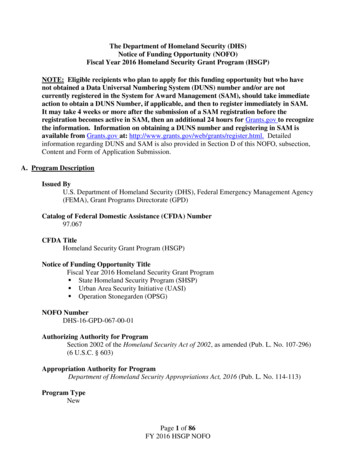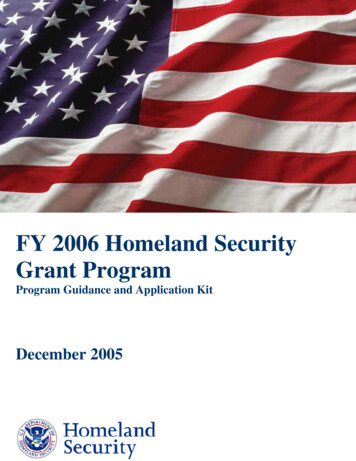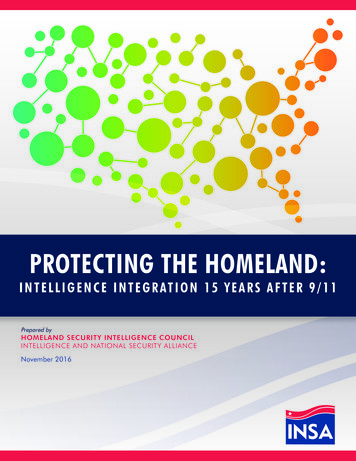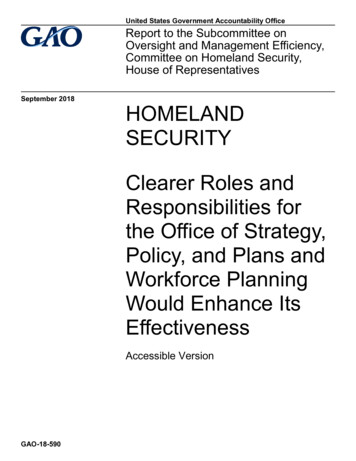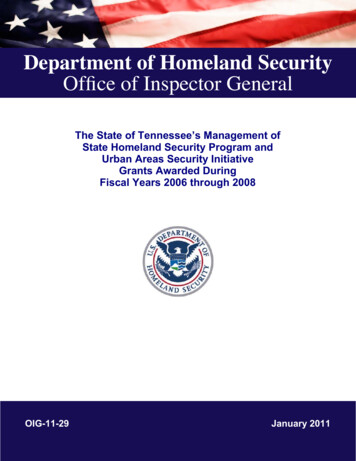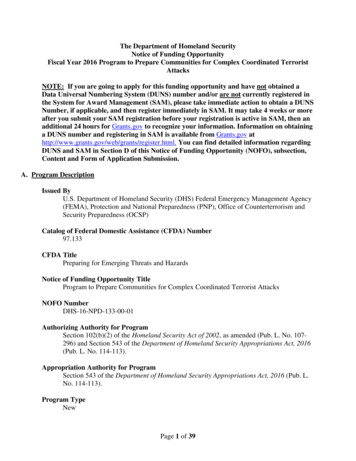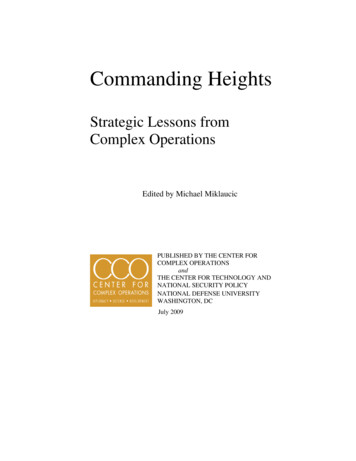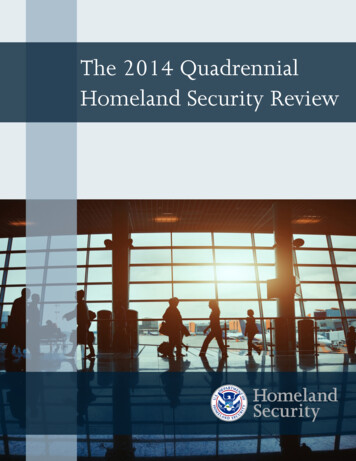
Transcription
The 2014 QuadrennialHomeland Security Review
This page intentionally left blank
LETTER FROM THE SECRETARYJune 18, 2014Pursuant to Section 707 of the Homeland Security Act of 2002(P.L. 107-296), as amended by the ImplementingRecommendations of the 9/11 Commission Act of 2007 (P.L.110-53), I am pleased to present the following report, Th e2014 Quadrennial Homeland Security Review. This reportprovides a strong analytic and strategic foundation for one ofmy highest priorities, which is ensuring that the Departmentinvests and operates in a cohesive, unified fashion and makesdecisions that strengthen Departmental unity of effort.Pursuant to congressional requirements, this report is beingprovided to the following Member of Congress:The Honorable Michael MccaulChairman, House Committee on Homeland SecurityThe Honorable Bennie G. ThompsonRanking Member, House Committee on Homeland SecurityThe Honorable Thomas R. CarperChairman, Senate Homeland Security and Governmental Affairs CommitteeThe Honorable Tom CoburnRanking Member, Senate Homeland Security and Governmental Affairs CommitteeThe first Quadrennial Homeland Security Review report was issued by OHS on February 1,2010. OHS began work on this second review two years ago and included consultationswith subject matter experts across the Federal Government, as well as state, local, tribal,and territorial governments, the private sector, and academic and other institutions.Since taking office as Secretary of OHS on December 23, 2013, I have reviewed this report,and I concur with its recommendations. Reflecting deep analysis of the evolving strategicenvironment and outlining the specific strategic shifts necessary to keep our Nation secure,this report reflects the more focused, collaborative Departmental strategy, planning, andanalytic capability that is necessary for achieving Departmental unity.Sincerely,
This page intentionally left blank
EXECUTIVE SUMMARYU.S. Coast GuardEXECUTIVE SUMMARYIn this report, we conclude that we will continue to adhere to the five basic homelandsecurity missions set forth in the first Quadrennial Homeland Security Review report in2010, but that these missions must be refined to reflect the evolving landscape ofhomeland security threats and hazards. The Deepwater Horizon oil spill in 2010, HurricaneSandy in 2012, and the Boston Marathon bombing in 2013 illustrate these evolving threatsand hazards. We must constantly learn from them and adapt. The terrorist threat isincreasingly decentralized and may be harder to detect. Cyber threats are growing andpose ever-greater concern to our critical infrastructure systems as they becomeincreasingly interdependent. Natural hazards are becoming more costly to address, withincreasingly variable consequences due in part to drivers such as climate change andinterdependent and aging infrastructure.Meanwhile, this Nation’s homeland security architecture has matured over the past fouryears, and we are determined that this progress continue. For example, our lawenforcement and intelligence communities are becoming increasingly adept at identifying2014 QUADRENNIAL HOMELAND SECURITY REVIEW5
EXECUTIVE SUMMARYand disrupting terrorist plotting in this country. Programs such as TSA Pre and GlobalEntry demonstrate the effectiveness and efficiency of risk-based security that can beachieved within budget constraints. It is also worth noting that, in late 2013, DHS receivedits first unqualified or “clean” audit opinion; this occurred just 10 years after theDepartment’s formation, which was the largest realignment and consolidation of FederalGovernment agencies and functions since the creation of the Department of Defense in1947.Here are our five basic homeland security missions, revised to address threats and hazardsover the next four years:Prevent Terrorism and Enhance Security. Preventing terrorist attacks on the Nation is andshould remain the cornerstone of homeland security. Since the last quadrennial review in2010, the terrorist threat to the Nation has evolved, but it remains real and may even beharder to detect. The Boston Marathon bombing illustrates the evolution of the threat.Through the U.S. Government’s counterterrorism efforts, we have degraded the ability ofal-Qa’ida’s senior leadership in Afghanistan and Pakistan to centrally plan and executesophisticated external attacks. But since 2009, we have seen the rise of al-Qa’idaaffiliates, such as al-Qa’ida in the Arabian Peninsula, which has made repeated attempts toexport terrorism to our Nation. Additionally, we face the threat of domestic-based “loneoffenders” and those who are inspired by extremist ideologies to radicalize to violence andcommit acts of terrorism against Americans and the Nation. These threats come inmultiple forms and, because of the nature of independent actors, may be hardest todetect. We must remain vigilant in detecting and countering these threats. Given thenature of this threat, engaging the public and private sectors through campaigns, such as“If You See Something, Say Something ” and the Nationwide Suspicious Activity ReportingInitiative, and through partnering across federal, state, local, tribal, and territorial lawenforcement will, over the next four years, become even more important.Secure and Manage Our Borders. We must continue to improve upon border security, toexclude terrorist threats, drug traffickers, and other threats to national security, economicsecurity, and public safety. We will rely on enhanced technology to screen incoming cargoat ports of entry and will work with foreign partners to monitor the international travel ofindividuals of suspicion who seek to enter this country. We will continue to emphasizerisk-based strategies that are smart, cost-effective, and conducted in a manner that isacceptable to the American people. We must remain agile in responding to new trends inillegal migration, from Central America or elsewhere. Meanwhile, we recognize theimportance of continuing efforts to promote and expedite lawful travel and trade that will62014 QUADRENNIAL HOMELAND SECURITY REVIEW
continue to strengthen our economy.Enforce and Administer Our Immigration Laws. We will continually work to better enforceour immigration laws and administer our immigration system. We support common-senseimmigration reform legislation that enhances border security, prevents and discouragesemployers from hiring undocumented workers, streamlines our immigration processingsystem, and provides an earned pathway to citizenship for the estimated 11.5 millionundocumented immigrants in this country. It is indeed a matter of homeland security andcommon sense that we encourage those physically present in this country to come out ofthe shadows and to be held accountable. Offering the opportunity to these 11.5 millionpeople—most of whom have been here 10 years or more and, in many cases, came here aschildren—is also consistent with American values and our Nation’s heritage. We will take asmart, effective, and efficient risk-based approach to border security and interiorenforcement and continually evaluate the best use of resources to prioritize the removal ofthose who represent threats to public safety and national security.Safeguard and Secure Cyberspace. We must, over the next four years, continue efforts toaddress the growing cyber threat, illustrated by the real, pervasive, and ongoing series ofattacks on our public and private infrastructure. This infrastructure provides essentialservices such as energy, telecommunications, water, transportation, and financial servicesand is increasingly subject to sophisticated cyber intrusions which pose new risks. As theFederal Government’s coordinator of efforts to counter cyber threats and other hazards tocritical infrastructure, DHS must work with both public and private sector partners to shareinformation, help make sure new infrastructure is designed and built to be more secureand resilient, and continue advocating internationally for openness and security of theInternet and harmony acrossinternational laws to combatcybercrime. Further, DHS mustsecure the Federal Government’sinformation technology systems byapproaching federal systems andnetworks as an integrated wholeand by researching, developing,and rapidly deploying cybersecuritysolutions and services at the pacethat cyber threats evolve. Andfinally, we must continue todevelop cyber law enforcement,U.S. Department of Homeland Security2014 QUADRENNIAL HOMELAND SECURITY REVIEW7
EXECUTIVE SUMMARYincident response, and reporting capabilities by increasing the number and impact ofcybercrime investigations, sharing information about tactics and methods of cybercriminals gleaned through investigations, and ensuring that incidents reported to anyfederal department or agency are shared across the U.S. Government. In addition, theFederal Government must continue to develop good working relationships with the privatesector, lower barriers to partnership, develop cybersecurity best practices, promoteadvanced technology that can exchange information at machine speed, and build the cyberworkforce of tomorrow for DHS and the Nation.Strengthen National Preparedness and Resilience. Acting on the lessons of HurricaneKatrina, we have improved disaster planning with federal, state, local, tribal, and territorialgovernments, as well as nongovernmental organizations and the private sector; prepositioned a greater number of resources; and strengthened the Nation’s ability to respondto disasters in a quick and robust fashion. Seven years after Katrina, the return on theseinvestments showed in the strong, coordinated response to Hurricane Sandy. We mustcontinue this progress.This review recognizes the environment in which we must pursue the homeland securitymissions over the next four years. To support priority security requirements in asustainable way, a corollary responsibility for DHS is to become more efficient and effectiveacross a large and decentralized structure. As a Department, we must eliminateduplicative processes, develop common platforms, and purchase single solutions, whilepursuing important commitments, such as the recapitalization of the aging Coast Guardfleet. DHS must and will also address the low morale that exists within many of itsComponents.Finally, we recognize that we operate at a time when the public’s confidence in thegovernment’s ability to function and work for them is low. DHS is unique among federalagencies for the large, daily engagement it has with the public at airports, seaports, andland ports of entry. Thus, the public’s attitude toward the entire Federal Government canbe shaped by interactions with DHS. Over the next four years, DHS will find opportunities topromote confidence in its ability to fulfill its mission.There is no more important function that a government can provide for its people thansafety and security. Through the leadership of our President, and in full partnership withother federal departments and agencies; state, local, tribal, and territorial governments;nongovernmental and private sector organizations; our foreign allies; and the Americanpublic, we will continue to work hard in pursuit of the homeland security missions; nothingless than the safety and security of the American people depend on this.82014 QUADRENNIAL HOMELAND SECURITY REVIEW
TABLE OF CONTENTSLetter from the Secretary . . .3Executive Summary . .51.Legal Requirement for the Review and Report . . .112.The Purpose of the Second Quadrennial Homeland Security Review. . . . 133.The Strategic Environment. . . . . 174.Guiding Principles. . . . . .305.Strategic Priorities. . . . . . 33 Securing Against the Evolving Terrorism Threat. . . .33 Safeguard and Secure Cyberspace . . . .39 A Homeland Security Strategy for Countering Biological Threats and Hazards . .46 A Risk Segmentation Approach to Securing and Managing Flows of People and Goods. . . . . .53 Strengthening the Execution of Our Missions Through Public-Private Partnerships . . . . . .586.Areas of Ongoing Priority and Emphasis . . . . 62 Nuclear Terrorism Using an Improvised Nuclear Device . . . . .62 Immigration . . .65 National Preparedness and the Whole Community Approach . . . . .717.Mission Framework In Depth . . . .758.Conclusion . . . .81Appendix A: HOMELAND SECURITY ROLES AND RESPONSIBILITIES . . . .83Appendix B: PROCESS AND STAKEHOLDER ENGAGEMENT ACTIVITIES . . 942014 QUADRENNIAL HOMELAND SECURITY REVIEW9
This page intentionally left blank102014 QUADRENNIAL HOMELAND SECURITY REVIEW
LEGAL REQUIREMENT FOR THE REVIEW AND REPORT1. LEGAL REQUIREMENT FOR THE REVIEW AND REPORTSection 707 of the Homeland Security Act of 2002 (P.L. 107-296), as amended by the ImplementingRecommendations of the 9/11 Commission Act of 2007 (P.L. 110-53), includes the following requirement:6 U.S.C. 347. QUADRENNIAL HOMELAND SECURITY REVIEW(a) Requirement(1) Quadrennial reviews requiredIn fiscal year 2009, and every 4 years thereafter, the Secretary shall conduct a review ofthe homeland security of the Nation (in this section referred to as a “quadrennialhomeland security review”).(2) Scope of reviewsEach quadrennial homeland security review shall be a comprehensive examination of thehomeland security strategy of the Nation, including recommendations regarding the longterm strategy and priorities of the Nation for homeland security and guidance on theprograms, assets, capabilities, budget, policies, and authorities of the Department.(3) ConsultationThe Secretary shall conduct each quadrennial homeland security review under thissubsection in consultation with-(A) the heads of other Federal agencies, including the Attorney General, the Secretaryof State, the Secretary of Defense, the Secretary of Health and Human Services, theSecretary of the Treasury, the Secretary of Agriculture, and the Director of NationalIntelligence;(B) key officials of the Department; and(C) other relevant governmental and nongovernmental entities, including state, local,and tribal government officials, members of Congress, private sector representatives,academics, and other policy experts.(4) Relationship with future years homeland security programThe Secretary shall ensure that each review conducted under this section is coordinatedwith the Future Years Homeland Security Program required under section 454 of this title.(b) Contents of reviewIn each quadrennial homeland security review, the Secretary shall-(1) delineate and update, as appropriate, the national homeland security strategy,consistent with appropriate national and Department strategies, strategic plans, andHomeland Security Presidential Directives, including the National Strategy for HomelandSecurity, the National Response Plan, and the Department Security Strategic Plan;(2) outline and prioritize the full range of the critical homeland security mission areas ofthe Nation;(3) describe the interagency cooperation, preparedness of Federal response assets,infrastructure, budget plan, and other elements of the homeland security program andpolicies of the Nation associated with the national homeland security strategy, required toexecute successfully the full range of missions called for in the national homeland securitystrategy described in paragraph (1) and the homeland security mission areas outlinedunder paragraph (2);(4) identify the budget plan required to provide sufficient resources to successfully executethe full range of missions called for in the national homeland security strategy described in2014 QUADRENNIAL HOMELAND SECURITY REVIEW11
LEGAL REQUIREMENT FOR THE REVIEW AND REPORTparagraph (1) and the homeland security mission areas outlined under paragraph (2);(5) include an assessment of the organizational alignment of the Department with thenational homeland security strategy referred to in paragraph (1) and the homeland securitymission areas outlined under paragraph (2); and(6) review and assess the effectiveness of the mechanisms of the Department forexecuting the process of turning the requirements developed in the quadrennial homelandsecurity review into an acquisition strategy and expenditure plan within the Department.(c) Reporting(1) In generalNot later than December 31 of the year in which a quadrennial homeland security review isconducted, the Secretary shall submit to Congress a report regarding that quadrennialhomeland security review.(2) Contents of reportEach report submitted under paragraph (1) shall include-(A) the results of the quadrennial homeland security review;(B) a description of the threats to the assumed or defined national homeland securityinterests of the Nation that were examined for the purposes of that review;(C) the national homeland security strategy, including a prioritized list of the criticalhomeland security missions of the Nation;(D) a description of the interagency cooperation, preparedness of Federal responseassets, infrastructure, budget plan, and other elements of the homeland securityprogram and policies of the Nation associated with the national homeland securitystrategy, required to execute successfully the full range of missions called for in theapplicable national homeland security strategy referred to in subsection (b)(1) of thissection and the homeland security mission areas outlined under subsection (b)(2) ofthis section;(E) an assessment of the organizational alignment of the Department with theapplicable national homeland security strategy referred to in subsection (b)(1) of thissection and the homeland security mission areas outlined under subsection (b)(2) ofthis section, including the Department's organizational structure, managementsystems, budget and accounting systems, human resources systems, procurementsystems, and physical and technical infrastructure;(F) a discussion of the status of cooperation among Federal agencies in the effort topromote national homeland security;(G) a discussion of the status of cooperation between the Federal Government andstate, local, and tribal governments in preventing terrorist attacks and preparing foremergency response to threats to national homeland security;(H) an explanation of any underlying assumptions used in conducting the review; and(I) any other matter the Secretary considers appropriate.(3) Public availabilityThe Secretary shall, consistent with the protection of national security and other sensitivematters, make each report submitted under paragraph (1) publicly available on theInternet website of the Department.(d) Authorization of appropriationsThere are authorized to be appropriated such sums as may be necessary to carry out thissection.122014 QUADRENNIAL HOMELAND SECURITY REVIEW
THE PURPOSE OF THE SECOND QHSRU.S. Coast Guard2. THE PURPOSE OF THE SECOND QUADRENNIAL HOMELANDSECURITY REVIEWMore than 12 years after the attacks of September 11, 2001, the United States is poisedto begin a new era in homeland security. Long-term changes in the security environmentand critical advances in homeland security capabilities require us to rethink the work DHSdoes with our partners—the work of building a safe, secure, and resilient Nation.This new era is defined by both positive and negative factors: the termination of offensivemilitary operations in Iraq and Afghanistan, two of the longest conflicts in U.S. history; therise of fiscal challenges at home and in partner states; global economic growth, temperedby increased volatility; growth in domestic energy supplies, contrasted with instability inmajor energy-producing regions; resource constraints in a more densely populated,urbanized world; and rapid technological change that impacts how we live, work,communicate, travel, and access knowledge.2014 QUADRENNIAL HOMELAND SECURITY REVIEW13
THE PURPOSE OF THE SECOND QHSRThis Quadrennial Homeland Security Review is consistent with, and supports the enduringnational interests of the United States, as articulated in our national security strategy: The security of the United States, its citizens, and U.S. allies and partners; A strong, innovative, and growing U.S. economy in an open international economicsystem that promotes opportunity and prosperity; Respect for universal values at home and around the world; and An international order advanced by U.S. leadership that promotes peace, security,and opportunity through stronger cooperation to meet global challenges.These national interests are inextricably linked and cannot be pursued in isolation.THE FIVE HOMELAND SECURITY MISSIONSThe first quadrennial review established the five enduring missions of homeland security.This review reaffirms the five-mission structure and updates the missions (detailed in theMission Framework In Depth section). The updated missions are: Prevent Terrorism and Enhance Security; Secure and Manage Our Borders; Enforce and Administer Our Immigration Laws; Safeguard and Secure Cyberspace; and Strengthen National Preparedness and Resilience.Accomplishing these missionsrequires unity of effort—bothacross every area of DHS activityand among the numeroushomeland security partners andstakeholders. The five missionsadvance each of the four enduringnational interests articulated inthe National Security Strategy.Successful accomplishment of14HOMELAND SECURITY VISIONA homeland that is safe, secure, andresilient against terrorism and otherhazards, where American interests,aspirations, and way of life can thrive.2014 QUADRENNIAL HOMELAND SECURITY REVIEW
Transportation Security Administrationthese missions results in a secure homeland, fosters a thriving economy, and protectsprivacy, civil rights, and civil liberties. We pursue enduring national interests and conductour missions in service to a single homeland security vision: a homeland that is safe,secure, and resilient against terrorism and other hazards, where American interests,aspirations, and way of life can thrive.As the threats and hazards we face change, the way we and our partners and stakeholderscarry out our missions must change as well. The second Quadrennial Homeland SecurityReview comprehensively examined the homeland security strategic environment andidentified strategic shifts and areas of ongoing priority and renewed emphasis for theNation’s long-term homeland security strategy.To set homeland security priorities, DHS leads national efforts to assess, analyze, andcompare risk—which is a function of the likelihood and potential impacts of differenthomeland security threats and hazards. However, we recognize that the likelihood andconsequence of specific threats and hazards may be influenced over time byinterdependent economic, political, social, environmental, and technological factors, aswell as trends and future uncertainties. We use systems analysis to create a more dynamicview of how these forces influence threats and hazards and how risk may change overtime. This forward-looking understanding of risk allows us to prioritize our actions withinthe five missions and maximize the use of our limited resources.2014 QUADRENNIAL HOMELAND SECURITY REVIEW15
THE PURPOSE OF THE SECOND QHSRBased on a deep examination of the strategic environment, we identified six drivers ofchange and six challenges that pose the most strategically significant risk over the next fiveyears (described in the Strategic Environment section). From those drivers and challenges,we identified the following strategic priorities that impact all five homeland securitymissions: An updated posture to address the increasingly decentralized terrorist threat; A strengthened path forward for cybersecurity that acknowledges the increasinginterdependencies among critical systems and networks; A homeland security strategy to manage the urgent and growing risk of biologicalthreats and hazards; A risk segmentation approach to securing and managing flows of people and goodsinto and out of the United States; and A new framework for improving the efficiency and effectiveness of our missionexecution through public-private partnerships.Beyond these strategic priorities, this second quadrennial review also highlights ongoingareas of priority and renewed areas of emphasis based on risk and other considerations—countering nuclear threats, strengthening our immigration system, and enhancing nationalresilience. Finally, building upon the first Quadrennial Homeland Security Review, thisreview provides an updated view of the Nation’s homeland security mission goals andobjectives.Federal Law Enforcement Training Center162014 QUADRENNIAL HOMELAND SECURITY REVIEW
THE STRATEGIC ENVIRONMENTU.S. Coast Guard3. THE STRATEGIC ENVIRONMENTDRIVERS OF CHANGEThis Nation’s homeland security architecture has matured over the past four years, asillustrated by the development of a One DHS approach to a range of homeland securitychallenges, and we are determined that this progress continue. For example, programssuch as TSA Pre and Global Entry demonstrate the effectiveness and efficiency ofrisk-based security and cross-Departmental integration that can be achieved within budgetconstraints. In addition, law enforcement is becoming increasingly adept at identifying anddisrupting terrorist plotting in this country. It is also worth noting that, in late 2013, DHSreceived its first unqualified or “clean” audit opinion; this occurred just 10 years after theDepartment’s formation, which was the largest realignment and consolidation of federalgovernment agencies and functions since the creation of the Department of Defense in1947.Our charge in the quadrennial review, however, is to identify and describe the threats to the2014 QUADRENNIAL HOMELAND SECURITY REVIEW17
THE STRATEGIC ENVIRONMENTNation’s homeland security interests. The first step in understanding threats and hazardsis identifying key areas of change. These areas of change are detailed below.THE EVOLVING TERRORISM THREATThe nature of the terrorist threat to the United States has evolved since the September 11,2001 attacks—and indeed, since the first Quadrennial Homeland Security Review in 2010.Counterterrorism pressure in the Afghanistan–Pakistan region has degraded the ability ofal-Qa’ida’s senior leadership to launch sophisticated external attacks, although theleadership that remains continues to aspire to attack the United States. At the same time,other groups affiliated and ideologically aligned with al-Qa’ida have emerged with the intentand, in some cases, the capability to carry out attacks against the United States andAmerican citizens overseas.Al-Qa’ida in the Arabian Peninsula is currently the al-Qa’ida affiliate of the greatest concernbecause of its demonstrated and continuing interest in advancing plots to attack theUnited States, particularlyagainst the aviationindustry.“The evolution of the terrorist threat demands awell-informed, highly agile, and well-networkedgroup of partners and stakeholders.”Also of concern aremilitants who supportal-Qa’ida’s internationalagenda and haveestablished bases of operation in conflict zones in the Middle East, West Africa, and NorthAfrica, particularly in Syria and neighboring states. These safe havens could allow them toplan and launch external operations and train recruits who have Western passports andwho can return home with combat skills and a violent anti-Western agenda.Al-Qa’ida, its affiliates, and adherents also use propaganda to inspire U.S.- and Westernbased supporters who have not traveled to conflict zones to conduct terrorist attacks. Loneoffenders—prime targets of English-language messaging by al-Qa’ida affiliates—tend tofavor plots involving the use of easily acquired weapons or explosives. Lone offenders andsmall groups acting on their own initiative and without direction of a terrorist group areamong the most persistent and difficult threats to counter. In recent years, there havebeen several acts of violence against military targets by lone offenders as well asattempted attacks on civilian populations by individuals motivated by al-Qa’ida. In addition,other groups and individuals inspired by a range of religious, political, or other ideologicalbeliefs have promoted and used violence against the United States. While not as182014 QUADRENNIAL HOMELAND SECURITY REVIEW
significant as the threat posed by al-Qa’ida, its adherents, and its affiliates, these othergroups and individuals remain a persistent threat.Improvised explosive devices continue to represent a significant threat because they areeasy to build and popular among violent extremists. Further, violent extremists have shownan enduring interest in improving improvised explosive device materials and methods toevade security measures. Violent extremists also seek to conduct small arms attacks.While violent extremists’ mistakes have sometimes contributed to intelligence and lawenforcement successes, plots using improvised explosive devices or small arms presentunique challenges as a result of being tactically simple and adaptable in both timing andlocation of execution, complicating discovery and disruption by authorities.Chemical, biological, radiological, and nuclear threats are enduring areas of concern; theconsequences of these attacks are potentially high even though the likelihood of theiroccurrence is relatively low. Small scale chemical attacks are expected to remain morelikely, because of accessibility to precursor materials and toxic industrial chemicals and therelative lack of specialized skills and knowledge required to conduct such attacks.However, nuclear terrorism and bioterrorism pose the most strategically significant risk, theformer because of its potential consequenc
security missions set forth in the first Quadrennial Homeland Security Review report in 2010, but that these missions must be refined to reflect the evolving landscape of homeland security threats and hazards. The Deepwater Horizon oil spill in 2010, Hurricane Sandy in 2012, and the Boston Marathon bombing in 2013 illustrate these evolving threats



